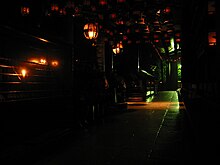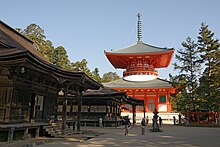Kōya-san


As Mount Kōya ( Jap. 高野山 ; Kōya = plateau san = mountain), a group of mountains is called in today's common usage of Japan Wakayama Prefecture south of Osaka , together with the enclosed by them plateau (altitude 800 m).
Actually, it is not a geographical name. Kōya-san is the nickname of the local Buddhist Kongōbu temple ( Kongōbu-ji , 金剛峯 寺 ). This covers the entire plateau with numerous sub-temples. Therefore, anyone who goes to the Kōya-san seeks this temple. All other temples are considered subordinate temples ( tatchū-jiin 塔 頭 寺院 ), which is why they have the designation -in ( 院 ) in their names .
Foundation and history
The area was developed in 816 by the Buddhist monk Kūkai alias Kōbō Daishi, who had managed to win the support of the Tennō saga . After the death of Kūkai, who found his final resting place here in 835, the Kōya-san developed into the most important site of the Shingon School next to the East Temple ( Tō-ji ) in Kyōto .
Only a few buildings were built during Kūkai's lifetime. After his death, the monk and abbot Shinzen Daitoku ( 真 然 大 徳 , approx. 804–891) continued to expand. In 887 the "Western Pagoda" ( Saitō ) was built. There were also the Yugi Pagoda ( Yugi-tō ), Miroku-Hall ( Miroku-dō ), the Shingon-Hall ( Shingon- do), the Juntei-Hall ( Juntei-do ), the bell tower ( Shōrō ) and the "Fundamental Grand Pagoda “( Kombon daitō ) in the area called Danjōgaran . However, fires triggered by lightning in 994 destroyed large parts of the facility. In the meantime there were hardly any monks left in the region, which was difficult to access at the time.
The decisive impulse for resuscitation came from the monk Jōyo ( 定 誉 , 958-1047), who worked in the Kōfuku temple ( Kōfuku-ji ) of Nara since he was 13 years old. In 1016, according to tradition, according to a revelation by the Bodhisattva Avalokiteshvara (Kannon), he rose to Kōya-san and developed means for the monks who followed his call to survive the harsh winters. With the honor Kūkai made by the Tennō Daigo in 921 as "Grand Master of Teaching Dissemination " ( Kōbō Daishi , 弘法 大師 ), Shingon Buddhism and thus also Kōya-san won the support of the highest circles. Both the Shirakawa Tennō and the Toba Tennō undertook the arduous pilgrimage. In the Kamakura period , influential warrior families established temples, and the number of large and small sub-temples and prayer halls swelled to over 2,000. During the Sengoku period in the 15th and 16th centuries, famous warriors found refuge here as monks after personal crises.
In the 16th century the lands given to the Kōya-san produced an annual income of 170,000 Koku rice. This amount allowed the maintenance of so-called warrior monks ( Sōhei ), who were a thorn in the side of those in power. While similarly fortified temples on Mount Hiei ( Hiei-zan ) and in Negoro ( Negoro-ji ) were attacked and burned by the troops of the general Toyotomi Hideyoshi , the Kōya-san escaped this fate. As the representative of the temple, Mokujiki Ōgo ( 木 食 應 其 ), a former military leader, swore absolute allegiance to Hideyoshi, so that there was a reduction in the extensive lands. In 1593 Hideyoshi even had the Seigan Temple ( Seigan-ji , 青 巌 ) built and made a pilgrimage here the following year on the occasion of the death of his mother. Even Tokugawa Ieyasu , the first shogun of the Tokugawa dynasty, the arduous journey was not afraid.
During the Edo period , the Kōya-san was under the patronage of the Tokugawa family and enjoyed a rice income of 120,000 koku . Regional princes erected stone pagodas along the pilgrimage routes, and many a well-known family found their final resting place in the valley floor in front of the Kukai mausoleum . Among the temples, the Seigan Temple and the Kōzan Temple ( Kōzan-ji , 興 山寺 ) with monastic scholars and administrative monks gained an increasingly important function. At the same time, the abbots of the Hōshō-temple ( Hōshō-in , 宝 性 院 ) and the Muryōju-temple ( Muryōju-in , 無量 寿 院 ) were in the same way as the regional princes the compulsion to "changing waiting" ( Sankin kōtai ) at court of the Shogun in Edo .
Reorganization and redefinition in the Meiji period
The Meiji government, installed after the fall of the last Tokugawa Shogun in 1868, propagated the separation of Buddhism and Shinto ( Shinbutsu-Bunri ) and promoted the establishment of a state Shinto closely linked to the imperial family . The measures that went deep into the previous structure did not leave the Kōya-san unaffected either. The Niutsu-hime shrine (alias Ama-no-sha) at the foot of the mountains, which has been closely connected to the Kōya-san since the early years, became independent. Women who had previously only been able to visit the “women's hall” ( Nyoin-dō ) at the seven entrances to the plateau were allowed to enter the entire region from 1872 onwards. In 1869 the Seigan Temple and the Kōzan Temple were merged to form the Kongōbu Temple ( Kongōbu-ji ). This has been the central temple ever since. But the entire plateau is still considered a temple. Its main hall ( Kondō ) is located in the Danjōgaran area. Most of the important ceremonies are held there. The Kongōbu Temple uses two emblems: a paulownia emblem ( gosan-kiri-mon ) and the triple tomoe emblem ( mitsudomoe-mon ).
With the forced return of the extensive lands and forests to the state, the economic basis of the temple collapsed. More than ever before one was dependent on the donations of pilgrims and on the devotional goods trade. Nevertheless, operations on the previous scale could not be maintained. In 1877 there was a first wave of amalgamation of various sub-temples, followed by a second wave in 1886. In addition, there were fires (1870, 1872, 1879, 1882, 1884, 1888), which destroyed numerous facilities. The major fire of 1888 in particular had disastrous effects.
In those years the Ministry of the Imperial Household (now the Imperial Court Office ) began investigating local cultural assets. After the passing of laws for the protection of old shrines and temples (1897), numerous objects and buildings achieved the status of an “important cultural asset” or “national treasure” . Since 1921, a museum called "House of Spiritual Treasures" ( Reihōkan ), which was built with donations, has been used to preserve and exhibit a total of 50,000 objects, including 21 "National Treasures " and 142 "Important Cultural Assets".
In the course of its 1200-year history, parts of the facility have repeatedly fallen victim to fires, be it lightning, arson or human error. The main hall ( Kondō ) of the Danjōgaran area was rebuilt seven times. The history of the "basic large pagoda" ( Kompondaitō ) goes back to the 9th century, the current building dates from 1937.
Kōya-san today
Today there are still 117 subordinate temples to the Kongōbu temple with around 600 monks and a university for religious studies founded in 1926 . About half of the temples offer pilgrims and tourists accommodation with vegetarian monks' food and the opportunity to take part in the morning devotion ( gongyō ). Administratively, the temples are part of the town of Kōya ( Kōya-chō , population including monks 3500 people), which has developed with the devotional trade and the supply of the temples, but has suffered from severe population decline since the 1990s.
There are a number of famous sites on the Kōya-san:
- Kongōbu-ji ( 金剛峰 寺 , lit. "Diamond Summit Temple"), next to the "Eastern Temple" ( Tō-ji ) in Kyoto the most important temple of the Shingon school;
- Danjōgaran ( 壇 上 伽藍 ), an area with a number of pagodas and halls, many of which are registered as cultural assets;
- Compos Daitō ( 根本 大 塔 , lit. "Basic Grand Pagoda"), a pagoda which, according to the teachings of Shingon Buddhism, forms the center of a spatial mandala that encompasses all of Japan;
- Oku-no-in ( 奥 の 院 , lit. rear hall), a small complex with the mausoleum of Kūkai in the back of a necropolis in the forest with the graves of well-known personalities and families from Japanese history;
- Sannō-in ( 山 王 院 , literally Temple of the Mountain King), a hall dedicated to the local Shinto deity. A number of important ceremonies take place there.
In 2004, Mount Kōya was along with other sites on the Kii Peninsula by the UNESCO as the site of the World Heritage declared. Since then, the number of foreign visitors has increased.
getting there
The Kōya-san has been accessible by trains on the Nankai Electric Railway since 1930 . The ride ends at the station Gokuraku bashi ( 極楽橋 , literally. "Paradise Bridge"). A funicular operated by the railway company transports visitors to the mountain station in five minutes. From there you can reach the core of the settlement by bus or taxi in around ten minutes.
Web links
- UNESCO World Heritage Site Kii Mountains (English)
- PDF brochure of the Koyasan Reihokan Museum (English)
- On the Koya-san Pilgrimage Trail (Travelnotes)
- Tourist information Koya-san (Rekishikaidō)
- Kōya city website (Japanese)
Coordinates: 34 ° 13 ' N , 135 ° 35' E
Picture gallery
Mitsugondō , a hall dedicated to Kakuban , the founder of the Shingi-Shingon school
Remarks
- ↑ The most important peaks are Mani-san (1004m) 、 Yōryū-san (1009m) 、 Tenjiku-san (915m) and Bentendake (984m).
- ↑ The association of temples with the name of the mountain in question ( sangō , 山 号 , lit. "mountain name") once emerged in China in order to distinguish temples of the same name by their geographical location. This type of temple name is not found in India, Thailand, Sri Lanka, etc.
- ↑ According to tradition, Kūkai is in the state of superconscious samadhi beyond life and death, in which he waits for the appearance of Maitreya , the Buddha of the future and coming world teacher.
- ↑ Garan , an abbreviation of sōgyaranma (僧伽 藍 摩, Skr. SaMghaaraama सँघाराम) literally means “garden for monks”. Originally a term for a place in the open air where monks gathered around their teachers, in Japan it was then also used for temple areas with assembly halls, etc.
- ↑ 1 Koku = 180.39 l, roughly the amount that an adult consumes in one year.
- ↑ mokujiki = wood eater
- ↑ Today only one of these halls remains
- ↑ This was also the coat of arms of the general and patron Toyotomi Hideyoshi.
Individual evidence
- ↑ For further details of the story, see the chronology of the Koya-san website (Japanese)
- ↑ Hinonishi, Shinjō: Kōyasan shinbutsu-bunri shiyō to sono kaisetsu . In: Mikkyōbunka , 120 (1977), pp. 22-41; 121 (1978), pp. 54-96 (日 野 西 眞 定 : 高 野山 神 仏 分離 史料 と そ の 解説. 密 教 文化)
- ↑ See the Japanese website of the "Koyasan Reihokan Museum"
- ↑ Asahi Shimbun, Jan. 15, 2014
- ^ Population statistics of the city of Kōya


















